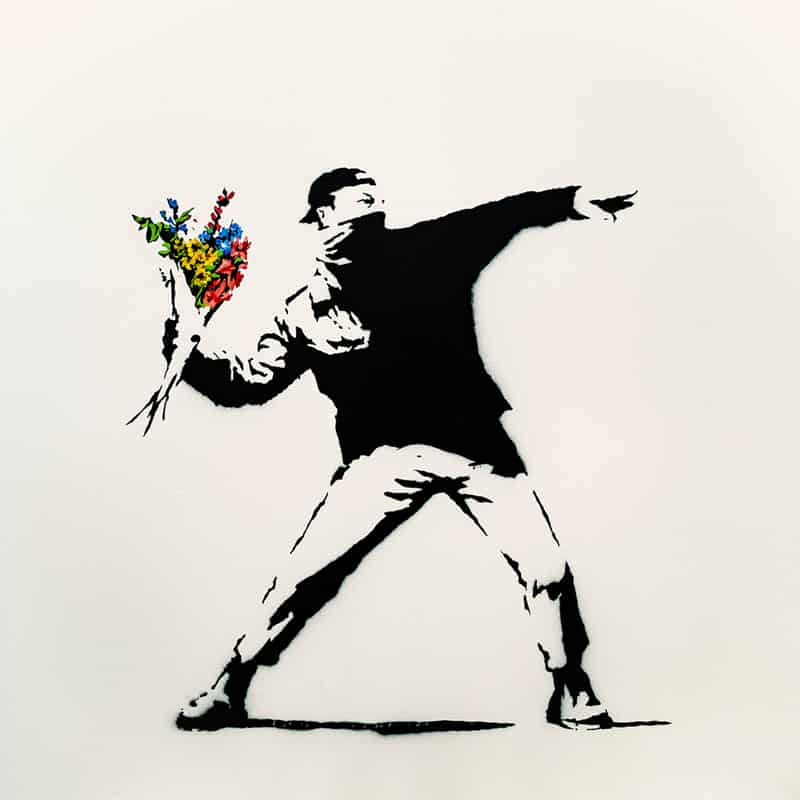Love is in the Air
Banksy, 2005
Acquired at Sotheby's
on 05/13/2021
Details
Banksy
b.1974
Love is in the Air
signed on the overlap; signed and dated 06/05/05 on the stretcher
oil and spray paint on canvas
35 ⅜ by 36 ⅜ in. 90 by 90 cm.
This work is accompanied by a Pest Control Certificate of Authenticity.
Cataloge Note
Love is in the Air is a masterpiece that epitomizes the unparalleled creative insurgency of Banksy’s oeuvre. Characterised by its recognisable subject, graphic force and visual directness, this iconic work has helped cement Banksy’s place as a decisive political gadfly for our time. Love is in the Air portrays a militant-dressed figure, leaning with a drawn back arm, as if prepared to hurl something with violent intent. Yet, here, the figure stands alone, removed from the seemingly riotous context that his movements insinuate. What one would assume a Molotov Cocktail being thrown at an unseen opponent is cleverly substituted with a floral bouquet. In its satiric splendour, the subject is portrayed ready to bomb an establishment with flowers, propagating a reimagined world – one that is a hopeful and peaceful resolution in conflict, delivered with the same explosive force as a grenade.
“All graffiti is low-level dissent, but stencils have an extra history. They’ve been used to start revolutions and to stop wars.” — Banksy
Today, Love is in the Air is recognised as one of Banksy’s most sought-after artworks. Selected as the front cover of his notable Wall and Piece 2005 Monograph, the image exists as part of a larger body of work referred to as Flower Thrower or LIITA that extends far beyond the realm of fine art. Its powerfully arresting image has been referenced, replicated and reproduced globally from a vast number of prints to numerous commodified goods and merchandise. It stands analogously to the historically iconic works which have come before it, such as Leonardo da Vinci’s Mona Lisa or Andy Warhol’s Marylin Diptych – establishing itself as an image of timeless ascendency.
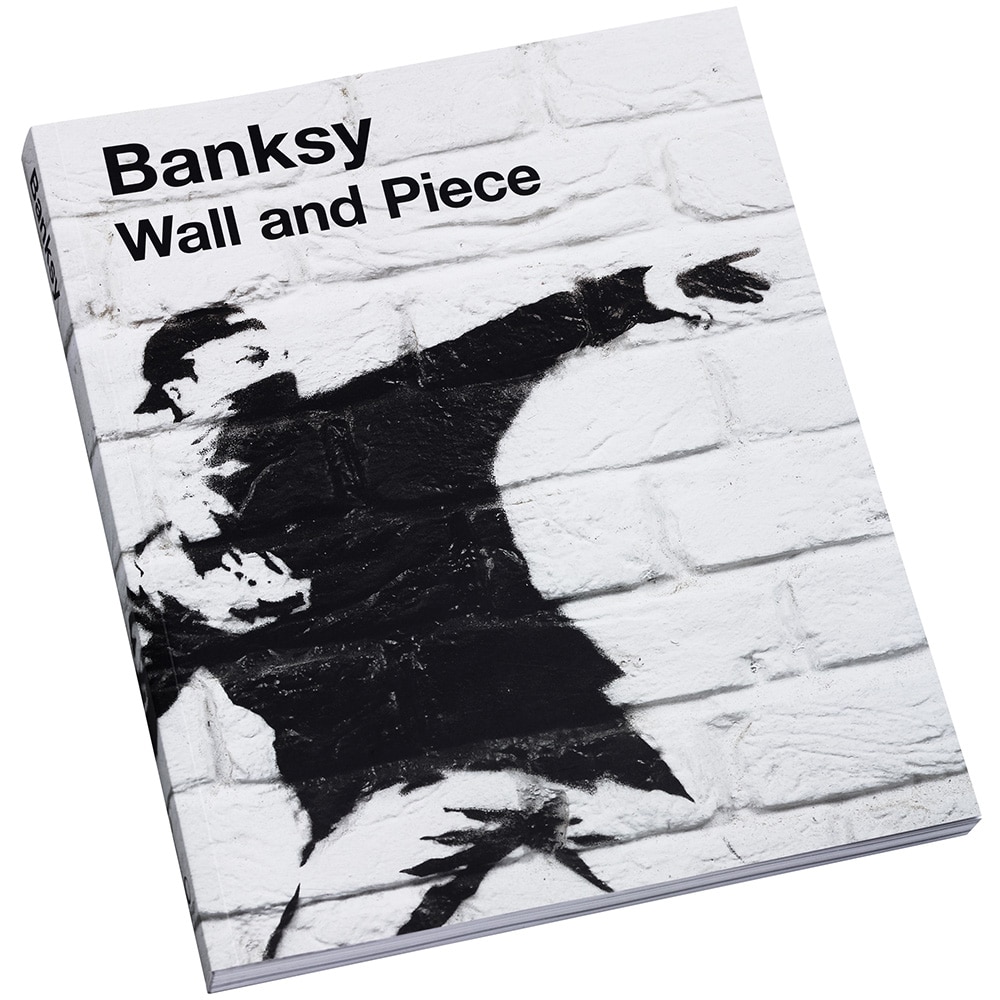
Love is in the Air, 2005 - Illustrated on the cover of Banksy: Wall and Piece Artwork © Banksy 2021
Contextual and historical significance
This work stands as the most powerful example of Banksy’s inimitable aptitude for conveying social satire with calculated moves intended to hit different notes on an emotional and intellectual scale. Indeed, Banksy’s first iteration of this work was in 2003, as a large format stencilled graffiti on the side of a garage in Beit Sahour in the Holy City of Jerusalem. This strategic location followed the construction of the West Bank Barrier separating Israel from the West Bank, and served to shed light on the absurdity of war and uneven power dynamics. The wall acted as a focal source of inspiration for Banksy, who returned frequently to create more stencilled art within the region, demonstrating his continued interest in unveiling the complex militarism and tensions caused by the Israeli-Palestinian conflict.
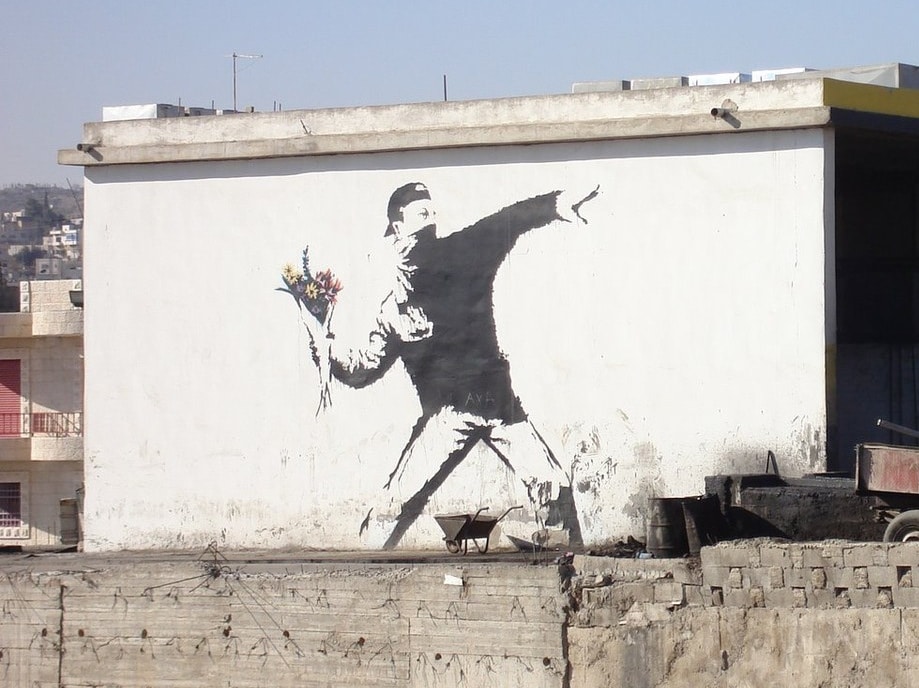
Banksy's famous mural rage, The flower thrower (Love is in the air) painted on a wall in Bethlehem, Palestine, Photo © Matthias Kestle / Alamy Stock Photo. Artwork: © Banksy 2021
The choice of color portrayed in the bouquet of flowers combine the colors of the Israeli and Palestinian flags – further underlining an opportunity to overcome discord and stand united. The various pieces by Banksy in this area highlight his self-proclamation as an artist and a communicator 'of the people.' He initiates discourse while demonstrating empathy with the daily processes of history and lived experience, and in turn, opts to disperse global issues such as prejudice, injustice and inequality. In 2017, Banksy opened The Walled Off Hotel alongside the Barrier wall in Bethlehem, proudly touting it as having “the worst view of any hotel in the world.” The original iteration on the West Bank Wall adheres to Banksy’s power in utilizing public architecture and urban settings to galvanise his message with both urgency and political perceptiveness.
Beholding and extending on art history
Banksy considers himself to be an extension of a larger modernist tradition by scrutinising the aesthetic language of Modernism from a distinctive cultural vantage point. Echoing the late-1960s student protesters from the Flower Power Movement that shook the United States and the United Kingdom during the Vietnam War, Love is in the Air brings to mind a contemporary update on a famous 1986 photograph in which rioters stuffed flowers into soldiers’ gun barrels.
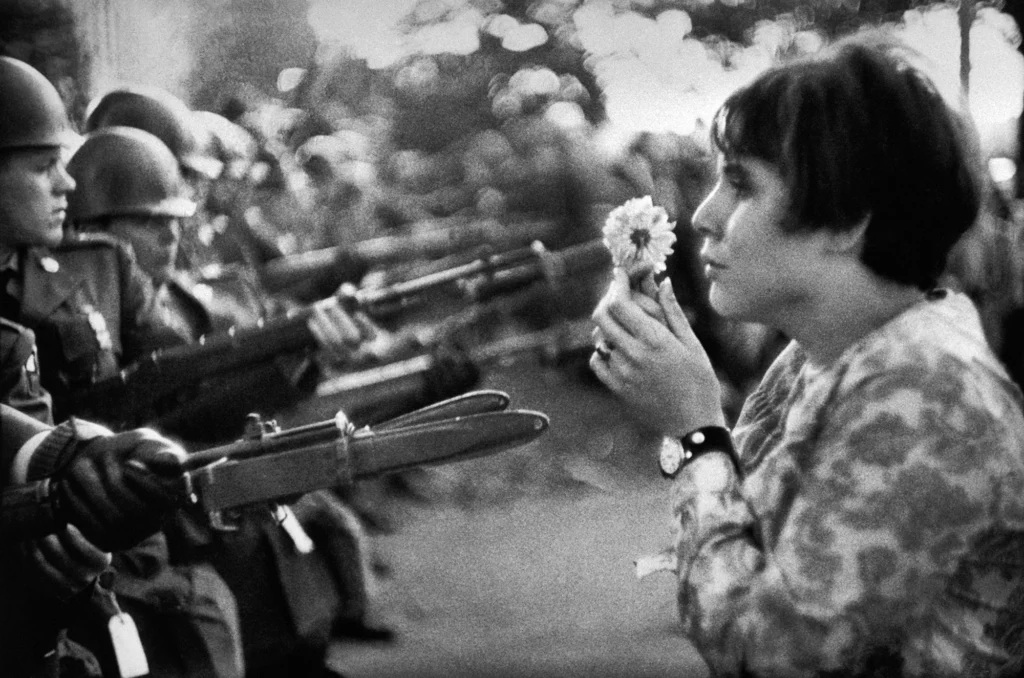
An American young girl, Jan Rose Kasmir, confronts the American National Guard outside the Pentagon during the 1967 anti-vietnam march. Photo © Marc Riboud | Magnum Photos.
The powerful anti-war sentiment present in this work is also reminiscent to one of the most famous 20th century paintings - Pablo Picasso’s 1937 Guernica. The mythical commemoration of the Spanish Civil war expressed Picasso’s vociferous outrage over the Nazi bombing of a Basque city in Nothern Spain and has been hailed internationally as one of the most moving anti-war representations. Painted entirely in monochrome, the scene depicts a cacophony of contorted movements evoked by adults, children and animals. Love is in the Air resonates a similar feeling present in Guernica’s loaded symbols. Symbolic of peace, the white Dove depicted in Picasso’s monumental painting is believed to be a emblem for the Holy Spirit breaking past darkness and ushering peace for the near future.
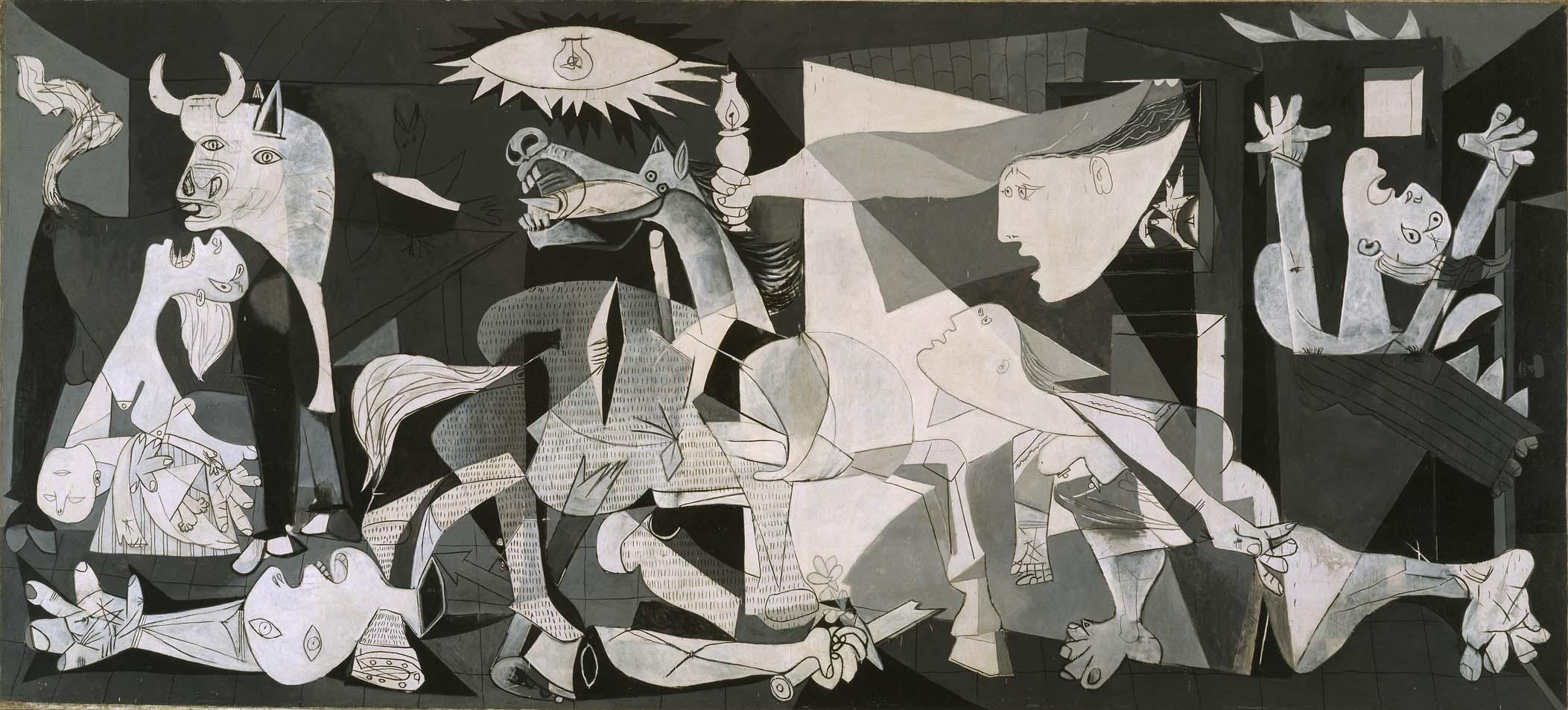
Pablo Picasso, Guernica, 1937, oil on canvas 3.49 x 7.77 meters.
Likewise, to the locals of Banksy’s original guerrilla iteration, the ‘flower thrower’ is said to evoke the angel statue at the Shepherds’ Field Chapel of Beit Sahour in the West Bank. The church is traditionally recognized as being the sacred place where an angel revealed the news of the birth of Jesus Christ - further symbolizing the language of hope and salvation central to Banksy’s practice.
In Picasso’s Guernica, a dead soldier is curiously ‘armed’ by a broken sword and a single white poppy. In both works, the flower’s presence in an otherwise violent scene foreshadows a peaceful outcome through the symbolization of regeneration, harmony and the remembrance of war.
Bridging the disparate realms of graffiti and fine art, Love is in the Air reminds us of the artist’s hand expressed by the rare inclusion of richly painted flowers in oils juxtaposing the quasi-mechanical process of his signature flat monochrome stencilled style. The stark contrast between the two opposing styles points to the urgency of the street amalgamated with the age-old trope of still life floral paintings that persist throughout art history. Wittily reinvigorated with boasting contemporaneity, the loosely painted flowers do not hold the same iconography as that of the majestic Renaissance flower paintings, momento moris or the sombre quality of the Dutch golden age. Instead, they deliberately appear as though having been swiftly clutched from a local store. Banksy’s incorporation of painted flowers contrasting a monochrome flat-stencilled image can also be regarded as wink to Warhol’s portraits of Mao. Where Warhol playfully uses Technicolor inks in contrast to his stencilled portrait to transform a powerful leader into a disarmed figure, Banksy paints vivid flowers to disarm the aggressive-looking posture of the rioter. The symbol of the flower traditionally assumed as fragile is re-energized from the out-dated virtues of womanhood into the only powerful weapon capable of bringing about real change.
In the venerable tradition of Andy Warhol’s silkscreened riot series, which focus on isolated intervals of deadly effects, Banksy seizes the violent act from its inevitable aftermath, by separating the subject into a sea of nothingness with none other than a vibrant bouquet of flowers.
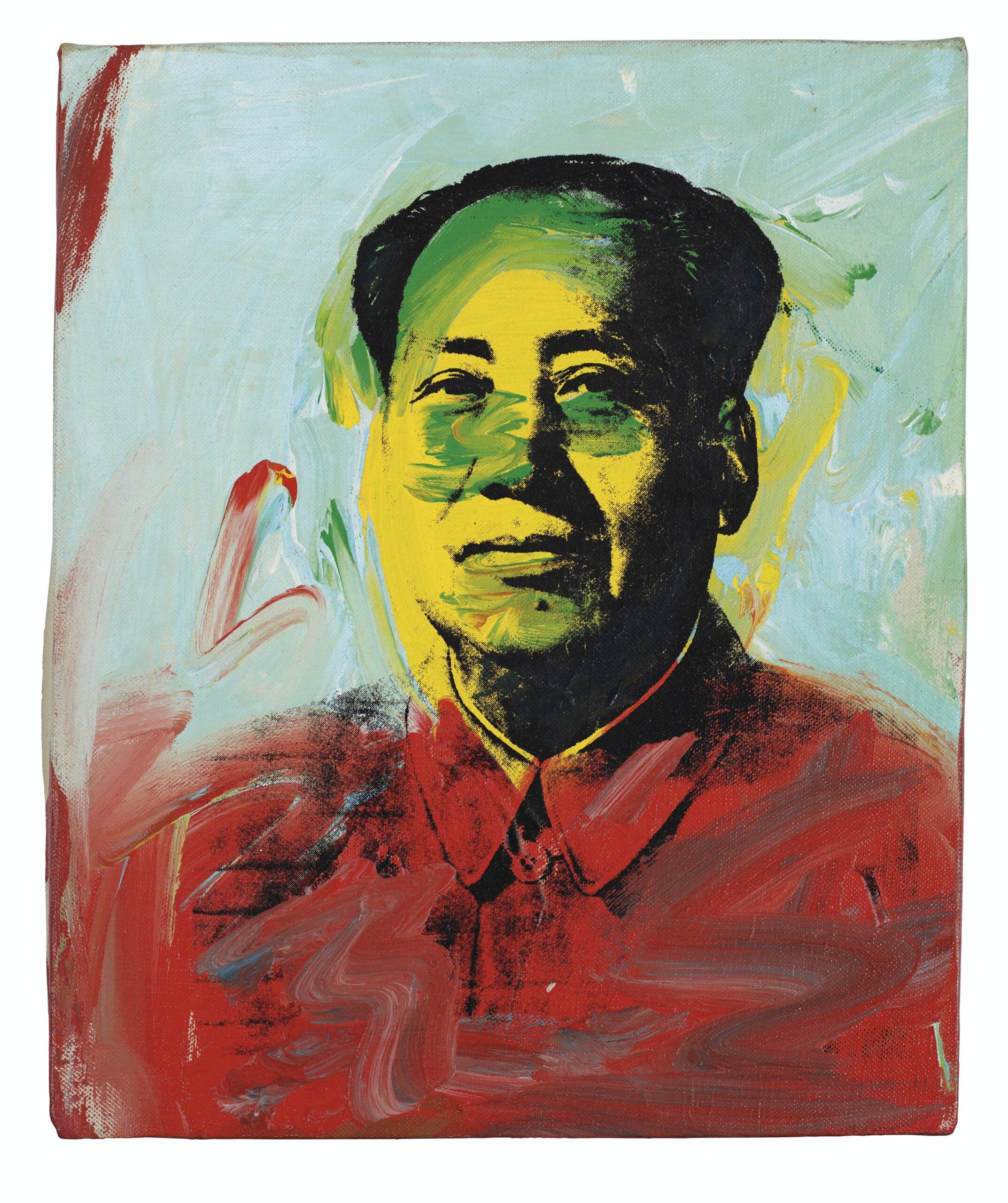
Pablo Picasso, Guernica, 1937, oil on canvas 3.49 x 7.77 meters.
Likewise, in a similar vein to Warhol’s riot imagery, which raised critical questions about the nature and role of media imagery and how they can be manipulated, to pacify or provoke – Banksy’s globally famous image of the flower thrower implicates society as witnesses to pursuing peace rather than violence. This is further exemplified by the piece sharing its title with a 1978 John Paul Young song – comically creating a carefree tone in what would otherwise suggest a foreboding outcome.
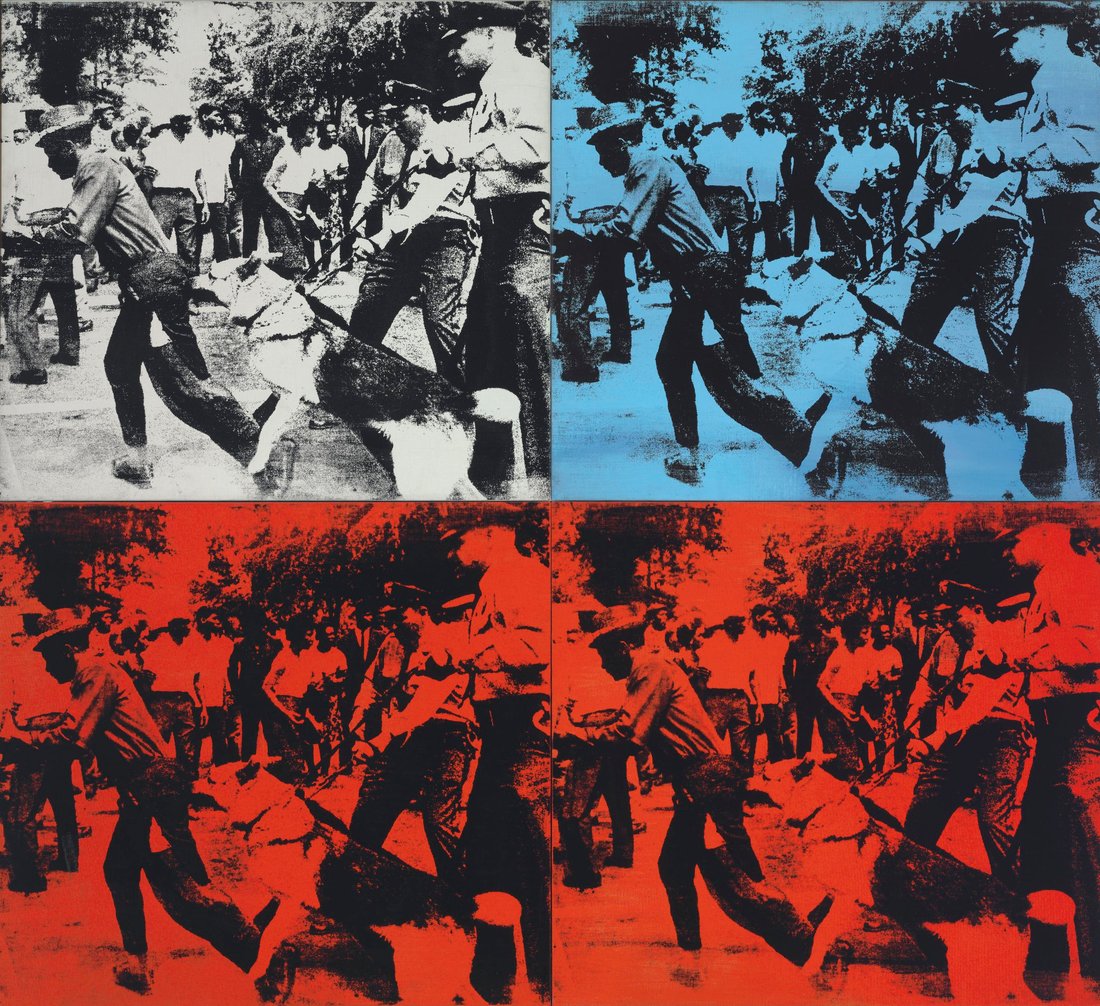
Andy Warhol, Race Riot, 1964, Private Collection. Art © 2021 Andy Warhol Foundation for the Visual Arts / Artists Rights Society (ARS), New York
Banksy weaves art-historical echoes—from the centuries-old still life traditions to the crisp stencilled flatness of Warhol’s world into a playful idiom that is entirely his own. He joins an opulent lineage stretching from 18th to 20th Century predecessors like William Hogarth, Honré Daumier and Marcel Duchamp who used recognisable ciphers and flipped them on their head to create provocative and satirical messages that bared the corruption and disarray of their time.
Banksy’s fearless attitude in making art that tackles the danger and darkness of real life head-on, is also redolent of Philip Guston’s mystique, who’s work witnesses a lexicon of forms and satirically comical characters that engage with the rigorous responsibilities of image-making. Guston’s hood paintings ambiguously evoking the Ku Klux Klan or hoods as masks in general, are at once sinister and goofy - transforming menacing presences into cartoonlike ghosts. At times assuming the hoods as alter egos/ self portraits by taking on the role of the enemy, Guston’s paintings took on a performative quality in their subject matter in order to examine role-play’s potential for both freedom and oppression.
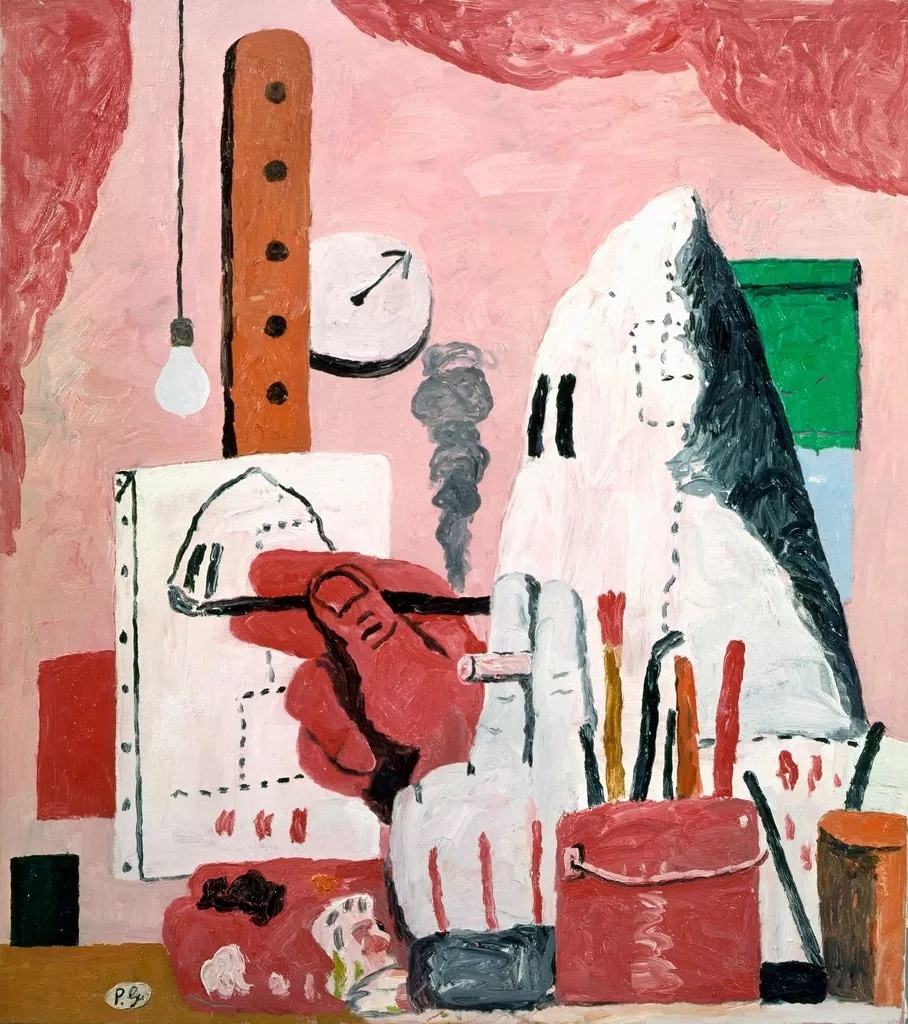
The Studio by Philip Guston, 1969, Oil on canvas, 71x73 in (180.3 x 186.1 cm) Photograph: Genevieve Hanson / © The Estate of Philip Guston, Courtesy Hauser & Wirth
Similiarly, the figure in Love is in the Air disguised by a bandana and a baseball can also stand as a self-portrait of the artist, who is notoriously known for his anonymous identity. He famously expressed, 'If you want to say something and have people listen then you have to wear a mask.’
An ode to the personal and drawn from the wider world, Love is in the Air stands as a radical image exploring the complicity in the act of art making. Banksy cultivates a complex dialogue in the confluence of diverse sources and prescient issues of our time to create a vision that powerfully rallies a call for change - looking across the ages with nostalgic purity, whilst remaining firmly rooted in contemporary reality and contemplating towards a more positive future.
Sign up to learn more
Company
Collection
About us
The Team
Newsroom
Blog
Legal
Banksy | Love is in the Air: Terms of Sale
Banksy | Love is in the Air: Donation Summary
H.R. Giger | Necronom (Alien III): Terms of Sale
H.R. Giger | Necronom (Alien III): Loan Agreement
Particle Protocol: Privacy Policy
Particle LIITA Bridge: Terms of Use
Copyright © 2022 Particle Collection. All rights reserved.
United States
Copyright © 2022 Particle Collection. All rights reserved.
United States
